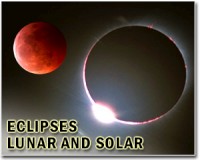 |
Moscow, Russia (RIA Novosti) Jan 04, 2011 Earthlings will have a chance to observe four solar and two total moon eclipses in 2011. The first solar eclipse will take place on January 4. It will begin at 06:40 GMT and will be visible from Europe, the Middle East and Northern Africa. At maximum eclipse in northern Europe, the Moon will cover 86 percent of the Sun's diameter. The next solar eclipse will occur on June 1. Residents of the Russian Kolguyev island in the Barents Sea will have a chance to observe the Moon covering 60 percent of the Sun's diameter. The eclipse will also be visible from the eastern Arctic, northern Canada, the Kamchatka peninsula and other regions of Russia's Far East. On June 15, a total moon eclipse will take place, visible from India, the Middle East, Africa and southern Europe. Soon after it, another solar eclipse will occur, but this time the Moon will cast its shadow on less then 0.1 percent of the Sun. On November 25, the Moon will cover a total of 90.4 percent of the Sun's diameter, but the eclipse will be visible only from Antarctica and its surrounding seas. Residents of the entire Eurasia, as well as of Australia and the north-western part of North America will have a chance to observe the second and the last total moon eclipse in 2011 on December 10.
Source: RIA Novosti
Share This Article With Planet Earth
Related Links - Solar and Lunar Eclipses at Skynightly
 Lunar eclipse makes memorable solstice
Lunar eclipse makes memorable solsticeReykjavik (AFP) Dec 21, 2010 Skygazers with a clear view in North America and Europe were greeted with a celestial treat early Tuesday, as a unique total lunar eclipse turned the Moon pink, coppery or even a blood red. Coinciding eerily with the northern hemisphere's mid-winter solstice - for the first time in almost four centuries - the eclipse showed the Sun, the Earth and its satellite as they directly aligned, wit ... read more |
|
| The content herein, unless otherwise known to be public domain, are Copyright 1995-2010 - SpaceDaily. AFP and UPI Wire Stories are copyright Agence France-Presse and United Press International. ESA Portal Reports are copyright European Space Agency. All NASA sourced material is public domain. Additional copyrights may apply in whole or part to other bona fide parties. Advertising does not imply endorsement,agreement or approval of any opinions, statements or information provided by SpaceDaily on any Web page published or hosted by SpaceDaily. Privacy Statement |